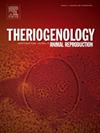Potential of mesenchymal stromal/stem cells and spermatogonial stem cells for survival and colonization in bull recipient testes after allogenic transplantation
IF 2.4
2区 农林科学
Q3 REPRODUCTIVE BIOLOGY
引用次数: 0
Abstract
Stem cell transplantation into seminiferous tubules of recipient testis could become a tool for fertility restoration, genetic improvement, or conservation of endangered species. Spermatogonial stem cells (SSCs) are primary candidates for transplantation; however, limited abundance, complexity for isolation and culture, and lack of specific markers have limited their use. Mesenchymal stromal/stem cells (MSCs) are multipotent progenitors that are simple to isolate and culture and possess specific markers for identification, and immune evasive and migratory capacities. The objective of the present study was to evaluate the potential for survival and colonization in seminiferous tubules of two different concentrations of bovine fetal adipose tissue-derived MSCs (AT-MSCs), native of pre-induced, and to compare the fate of bovine adult peripheral blood-derived MSCs (PB-MSCs) and SSCs after allogenic transplantation in testis of recipient bulls. In experiment 1, AT-MSCs at two concentrations (1x107 and 2x107; n = 3) or pre-exposed to 2 μM testosterone and 1 μM retinoic acid (RA) for 14 days (n = 5) were evaluated. In experiment 2, adult PB-MSCs and SSCs (4x107 cells each) pre-exposed to Sertoli cell conditioned media (SCs/CM; n = 4) for 14 days were compared. Each cell type was separately labelled with PKH26 and then transplanted into testes of 8-month-old recipient bulls. Four weeks (Exp. 1) and two weeks (Exp. 2) after transplantation, testicular tissue was processed for confocal microscopy detection of PKH26-positive cells. Mean number of PKH26-positive cells were higher (P < 0.05) in testis transplanted with 2x107 AT-MSCs in the proximal (6.7 ± 3.7) and medial (6.6 ± 3.2) sections compared to testis transplanted with 1x107 AT-MSCs (proximal: 1.9 ± 1; medial: 1.9 ± 1) sections or pre-induced AT-MSCs (proximal: 4.7 ± 5.6; medial: 3.8 ± 4.1). In Exp. 2, mean number of PKH26-positive SSCs in medial testicular section (22.5 ± 1.3) were higher (P < 0.05) compared to respective section in PB-MSCs group (17 ± 4.2). Thus, in vivo data indicates that a higher number of transplanted AT-MSCs resulted in more cells surviving and colonizing seminiferous tubules; however, pre-induction with testosterone and RA did not improve these capacities. SSCs displayed a greater capacity for survival and colonization in recipient seminiferous tubules; however, PB-MSCs were observed in all sections of testis after two weeks of transplantation.
间充质基质/干细胞和精原干细胞在异基因移植后在公牛受体睾丸中存活和定植的潜力
将干细胞移植到受体睾丸的曲细精管可能成为恢复生育能力、改良基因或保护濒危物种的工具。精原干细胞(SSCs)是移植的主要候选者;然而,由于其数量有限、分离和培养复杂以及缺乏特异性标记,限制了它们的使用。间充质基质/干细胞(MSCs)是多能祖细胞,分离和培养简单,具有特异性鉴定标记,具有免疫回避和迁移能力。本研究旨在评估两种不同浓度的牛胎儿脂肪组织间充质干细胞(AT-MSCs)(原生间充质干细胞和预诱导间充质干细胞)在曲细精管中的存活和定植潜力,并比较牛成人外周血间充质干细胞(PB-MSCs)和间充质干细胞异基因移植到受体公牛睾丸后的命运。实验 1 评估了两种浓度(1x107 和 2x107;n = 3)的 AT-MSCs 或预先暴露于 2 μM 睾酮和 1 μM 视黄酸(RA)14 天的 AT-MSCs (n = 5)。在实验 2 中,对预先暴露于 Sertoli 细胞条件培养基(SCs/CM;n = 4)14 天的成体 PB-MSCs 和 SSCs(各 4x107 个细胞)进行了比较。每种细胞都分别用 PKH26 标记,然后移植到 8 个月大的受体公牛的睾丸中。移植后四周(实验 1)和两周(实验 2),对睾丸组织进行处理,用共聚焦显微镜检测 PKH26 阳性细胞。与移植了 1x107 AT-MSCs(近端:1.9 ± 1;中端:1.9 ± 1)或诱导前 AT-MSCs(近端:4.7 ± 5.6;中端:3.8 ± 4.1)的睾丸相比,移植了 2x107 AT-MSCs 的睾丸近端(6.7 ± 3.7)和内侧(6.6 ± 3.2)切片中 PKH26 阳性细胞的平均数量更高(P < 0.05)。在实验 2 中,睾丸内侧切片(22.5 ± 1.3)中 PKH26 阳性的 SSCs 平均数量(P < 0.05)高于 PB-MSCs 组相应切片(17 ± 4.2)。因此,体内数据表明,移植的AT-间充质干细胞数量越多,存活和定植到曲细精管的细胞就越多;然而,预先诱导睾酮和RA并不能提高这些能力。造血干细胞在受体曲细精管中的存活和定植能力更强;然而,移植两周后,在睾丸的所有切片中都观察到了PB-造血干细胞。
本文章由计算机程序翻译,如有差异,请以英文原文为准。
求助全文
约1分钟内获得全文
求助全文
来源期刊

Theriogenology
农林科学-生殖生物学
CiteScore
5.50
自引率
14.30%
发文量
387
审稿时长
72 days
期刊介绍:
Theriogenology provides an international forum for researchers, clinicians, and industry professionals in animal reproductive biology. This acclaimed journal publishes articles on a wide range of topics in reproductive and developmental biology, of domestic mammal, avian, and aquatic species as well as wild species which are the object of veterinary care in research or conservation programs.
 求助内容:
求助内容: 应助结果提醒方式:
应助结果提醒方式:


